Workplace Health and Safety Risk Assessment and Analysis: Fox and Bow
VerifiedAdded on 2023/06/05
|13
|1676
|125
Report
AI Summary
This report presents a workplace health and safety (WHS) risk assessment and analysis for the Fox and Bow restaurant, a family-run cafe in Canberra, Australia. The assessment focuses on the commercial cookery environment, identifying potential hazards such as unguarded cooking pans, slips and falls, cuts from knives, and manual handling of heavy items. The report details existing control measures, risk scores, and required actions to mitigate these hazards. It includes a WHS risk assessment template, outlining steps for describing activities, identifying hazards, assessing potential risks, and implementing control measures. The analysis uses a risk matrix to evaluate the likelihood and consequences of identified hazards, determining risk levels and recommending specific actions for each hazard, including training, improved housekeeping, and equipment maintenance. The report also provides definitions of likelihood, consequences, and risk scores, along with a hierarchy of risk controls and references.
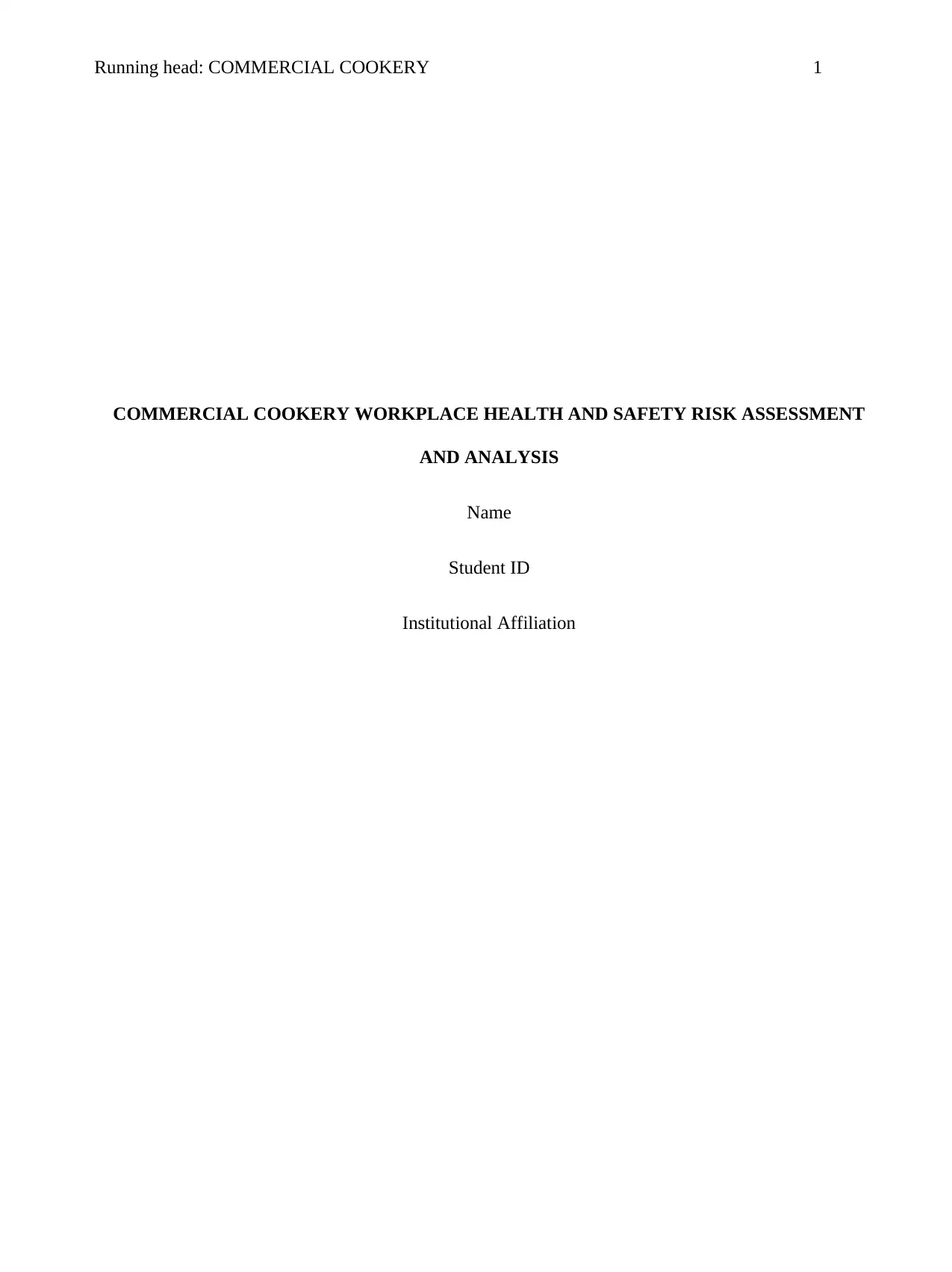
Running head: COMMERCIAL COOKERY 1
COMMERCIAL COOKERY WORKPLACE HEALTH AND SAFETY RISK ASSESSMENT
AND ANALYSIS
Name
Student ID
Institutional Affiliation
COMMERCIAL COOKERY WORKPLACE HEALTH AND SAFETY RISK ASSESSMENT
AND ANALYSIS
Name
Student ID
Institutional Affiliation
Paraphrase This Document
Need a fresh take? Get an instant paraphrase of this document with our AI Paraphraser
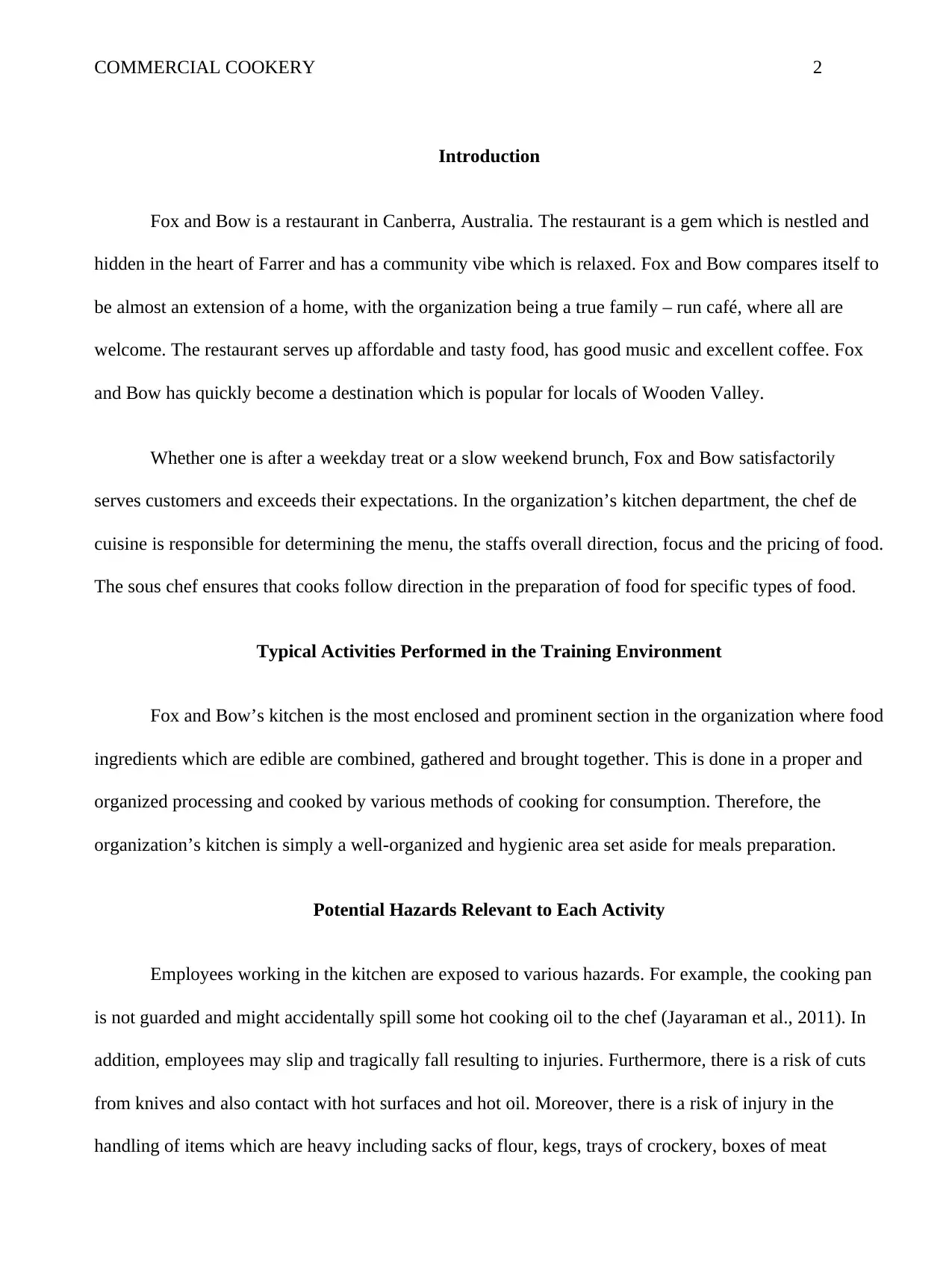
COMMERCIAL COOKERY 2
Introduction
Fox and Bow is a restaurant in Canberra, Australia. The restaurant is a gem which is nestled and
hidden in the heart of Farrer and has a community vibe which is relaxed. Fox and Bow compares itself to
be almost an extension of a home, with the organization being a true family – run café, where all are
welcome. The restaurant serves up affordable and tasty food, has good music and excellent coffee. Fox
and Bow has quickly become a destination which is popular for locals of Wooden Valley.
Whether one is after a weekday treat or a slow weekend brunch, Fox and Bow satisfactorily
serves customers and exceeds their expectations. In the organization’s kitchen department, the chef de
cuisine is responsible for determining the menu, the staffs overall direction, focus and the pricing of food.
The sous chef ensures that cooks follow direction in the preparation of food for specific types of food.
Typical Activities Performed in the Training Environment
Fox and Bow’s kitchen is the most enclosed and prominent section in the organization where food
ingredients which are edible are combined, gathered and brought together. This is done in a proper and
organized processing and cooked by various methods of cooking for consumption. Therefore, the
organization’s kitchen is simply a well-organized and hygienic area set aside for meals preparation.
Potential Hazards Relevant to Each Activity
Employees working in the kitchen are exposed to various hazards. For example, the cooking pan
is not guarded and might accidentally spill some hot cooking oil to the chef (Jayaraman et al., 2011). In
addition, employees may slip and tragically fall resulting to injuries. Furthermore, there is a risk of cuts
from knives and also contact with hot surfaces and hot oil. Moreover, there is a risk of injury in the
handling of items which are heavy including sacks of flour, kegs, trays of crockery, boxes of meat
Introduction
Fox and Bow is a restaurant in Canberra, Australia. The restaurant is a gem which is nestled and
hidden in the heart of Farrer and has a community vibe which is relaxed. Fox and Bow compares itself to
be almost an extension of a home, with the organization being a true family – run café, where all are
welcome. The restaurant serves up affordable and tasty food, has good music and excellent coffee. Fox
and Bow has quickly become a destination which is popular for locals of Wooden Valley.
Whether one is after a weekday treat or a slow weekend brunch, Fox and Bow satisfactorily
serves customers and exceeds their expectations. In the organization’s kitchen department, the chef de
cuisine is responsible for determining the menu, the staffs overall direction, focus and the pricing of food.
The sous chef ensures that cooks follow direction in the preparation of food for specific types of food.
Typical Activities Performed in the Training Environment
Fox and Bow’s kitchen is the most enclosed and prominent section in the organization where food
ingredients which are edible are combined, gathered and brought together. This is done in a proper and
organized processing and cooked by various methods of cooking for consumption. Therefore, the
organization’s kitchen is simply a well-organized and hygienic area set aside for meals preparation.
Potential Hazards Relevant to Each Activity
Employees working in the kitchen are exposed to various hazards. For example, the cooking pan
is not guarded and might accidentally spill some hot cooking oil to the chef (Jayaraman et al., 2011). In
addition, employees may slip and tragically fall resulting to injuries. Furthermore, there is a risk of cuts
from knives and also contact with hot surfaces and hot oil. Moreover, there is a risk of injury in the
handling of items which are heavy including sacks of flour, kegs, trays of crockery, boxes of meat
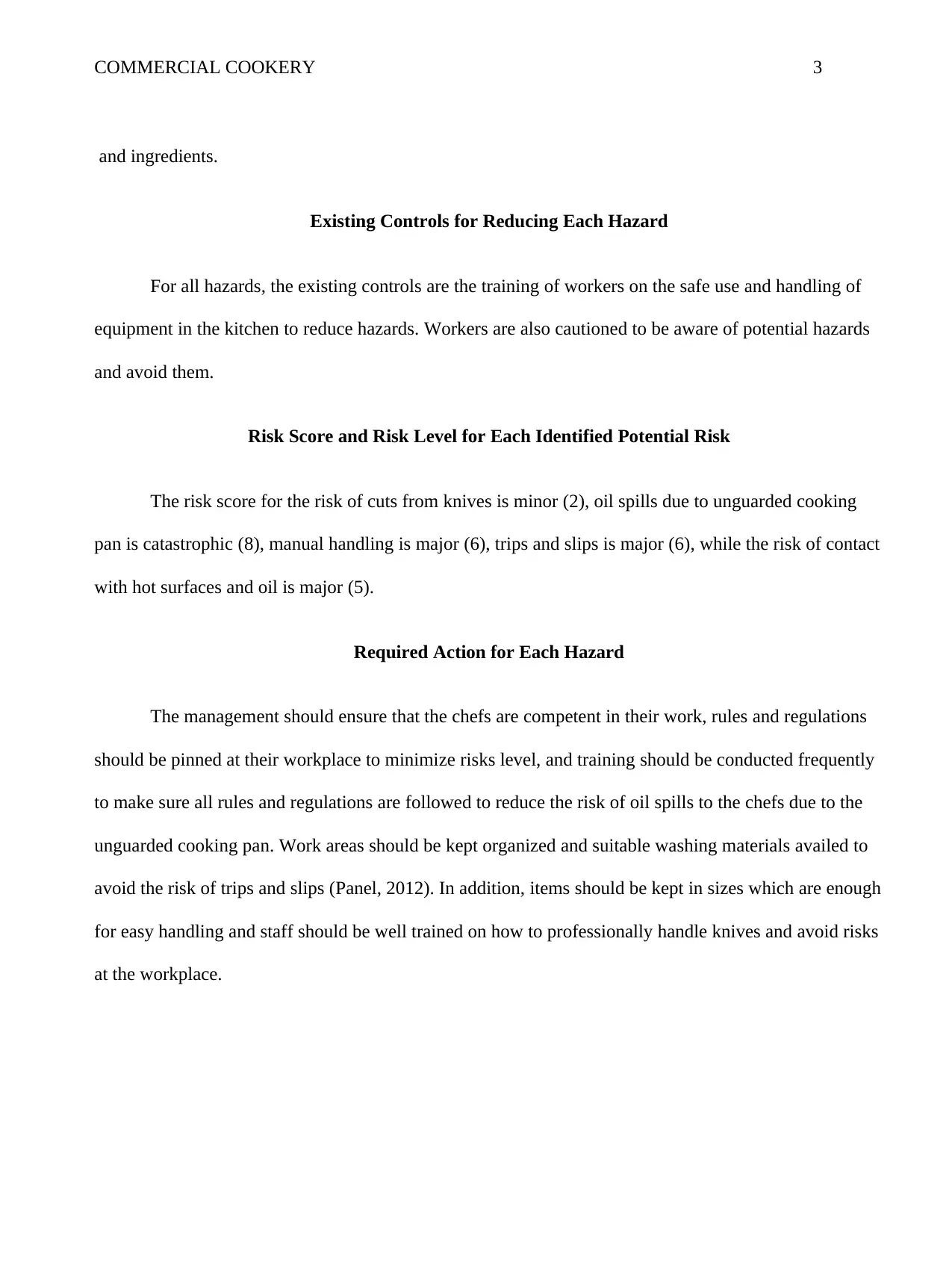
COMMERCIAL COOKERY 3
and ingredients.
Existing Controls for Reducing Each Hazard
For all hazards, the existing controls are the training of workers on the safe use and handling of
equipment in the kitchen to reduce hazards. Workers are also cautioned to be aware of potential hazards
and avoid them.
Risk Score and Risk Level for Each Identified Potential Risk
The risk score for the risk of cuts from knives is minor (2), oil spills due to unguarded cooking
pan is catastrophic (8), manual handling is major (6), trips and slips is major (6), while the risk of contact
with hot surfaces and oil is major (5).
Required Action for Each Hazard
The management should ensure that the chefs are competent in their work, rules and regulations
should be pinned at their workplace to minimize risks level, and training should be conducted frequently
to make sure all rules and regulations are followed to reduce the risk of oil spills to the chefs due to the
unguarded cooking pan. Work areas should be kept organized and suitable washing materials availed to
avoid the risk of trips and slips (Panel, 2012). In addition, items should be kept in sizes which are enough
for easy handling and staff should be well trained on how to professionally handle knives and avoid risks
at the workplace.
and ingredients.
Existing Controls for Reducing Each Hazard
For all hazards, the existing controls are the training of workers on the safe use and handling of
equipment in the kitchen to reduce hazards. Workers are also cautioned to be aware of potential hazards
and avoid them.
Risk Score and Risk Level for Each Identified Potential Risk
The risk score for the risk of cuts from knives is minor (2), oil spills due to unguarded cooking
pan is catastrophic (8), manual handling is major (6), trips and slips is major (6), while the risk of contact
with hot surfaces and oil is major (5).
Required Action for Each Hazard
The management should ensure that the chefs are competent in their work, rules and regulations
should be pinned at their workplace to minimize risks level, and training should be conducted frequently
to make sure all rules and regulations are followed to reduce the risk of oil spills to the chefs due to the
unguarded cooking pan. Work areas should be kept organized and suitable washing materials availed to
avoid the risk of trips and slips (Panel, 2012). In addition, items should be kept in sizes which are enough
for easy handling and staff should be well trained on how to professionally handle knives and avoid risks
at the workplace.
⊘ This is a preview!⊘
Do you want full access?
Subscribe today to unlock all pages.

Trusted by 1+ million students worldwide
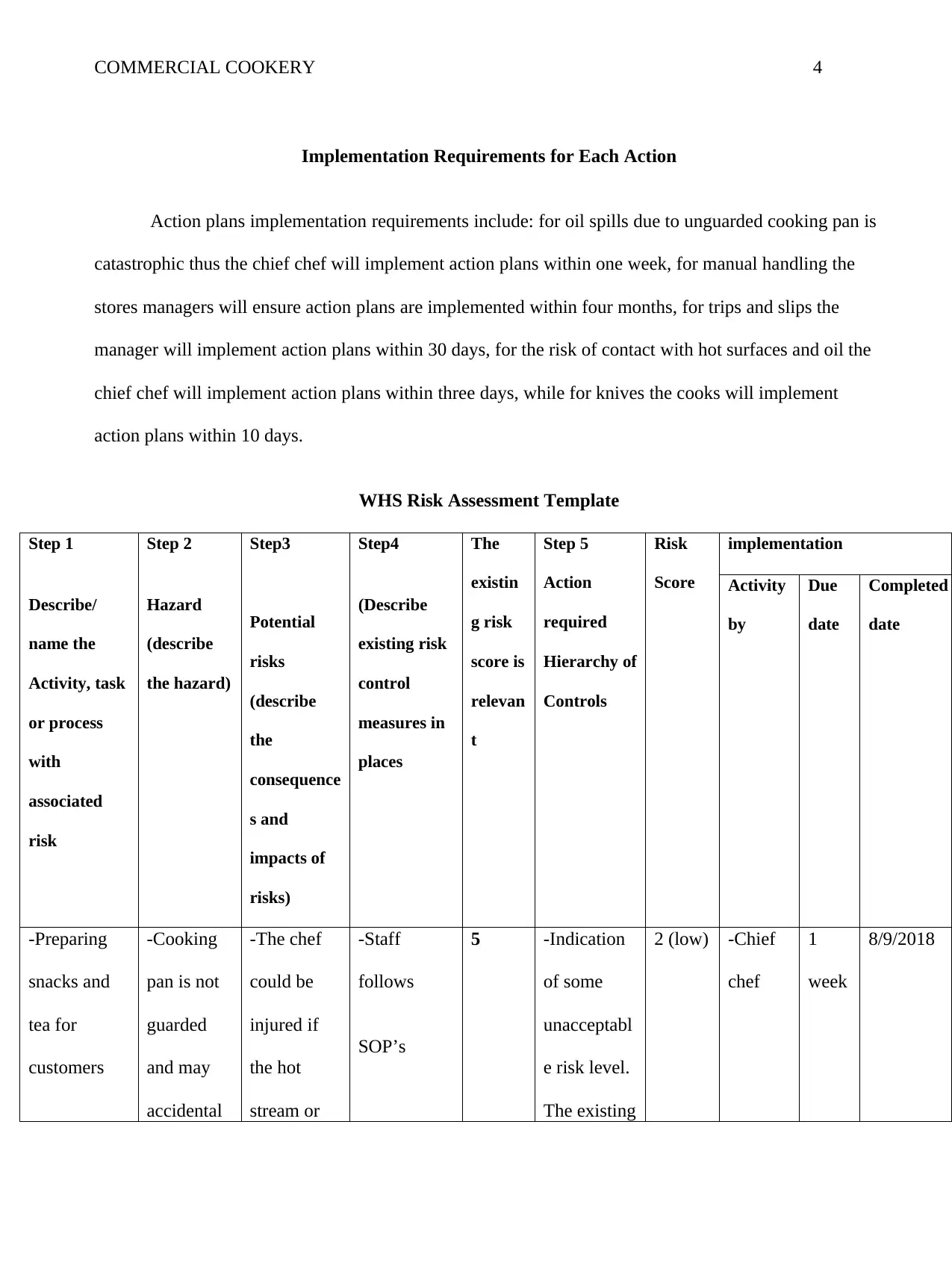
COMMERCIAL COOKERY 4
Implementation Requirements for Each Action
Action plans implementation requirements include: for oil spills due to unguarded cooking pan is
catastrophic thus the chief chef will implement action plans within one week, for manual handling the
stores managers will ensure action plans are implemented within four months, for trips and slips the
manager will implement action plans within 30 days, for the risk of contact with hot surfaces and oil the
chief chef will implement action plans within three days, while for knives the cooks will implement
action plans within 10 days.
WHS Risk Assessment Template
Step 1
Describe/
name the
Activity, task
or process
with
associated
risk
Step 2
Hazard
(describe
the hazard)
Step3
Potential
risks
(describe
the
consequence
s and
impacts of
risks)
Step4
(Describe
existing risk
control
measures in
places
The
existin
g risk
score is
relevan
t
Step 5
Action
required
Hierarchy of
Controls
Risk
Score
implementation
Activity
by
Due
date
Completed
date
-Preparing
snacks and
tea for
customers
-Cooking
pan is not
guarded
and may
accidental
-The chef
could be
injured if
the hot
stream or
-Staff
follows
SOP’s
5 -Indication
of some
unacceptabl
e risk level.
The existing
2 (low) -Chief
chef
1
week
8/9/2018
Implementation Requirements for Each Action
Action plans implementation requirements include: for oil spills due to unguarded cooking pan is
catastrophic thus the chief chef will implement action plans within one week, for manual handling the
stores managers will ensure action plans are implemented within four months, for trips and slips the
manager will implement action plans within 30 days, for the risk of contact with hot surfaces and oil the
chief chef will implement action plans within three days, while for knives the cooks will implement
action plans within 10 days.
WHS Risk Assessment Template
Step 1
Describe/
name the
Activity, task
or process
with
associated
risk
Step 2
Hazard
(describe
the hazard)
Step3
Potential
risks
(describe
the
consequence
s and
impacts of
risks)
Step4
(Describe
existing risk
control
measures in
places
The
existin
g risk
score is
relevan
t
Step 5
Action
required
Hierarchy of
Controls
Risk
Score
implementation
Activity
by
Due
date
Completed
date
-Preparing
snacks and
tea for
customers
-Cooking
pan is not
guarded
and may
accidental
-The chef
could be
injured if
the hot
stream or
-Staff
follows
SOP’s
5 -Indication
of some
unacceptabl
e risk level.
The existing
2 (low) -Chief
chef
1
week
8/9/2018
Paraphrase This Document
Need a fresh take? Get an instant paraphrase of this document with our AI Paraphraser
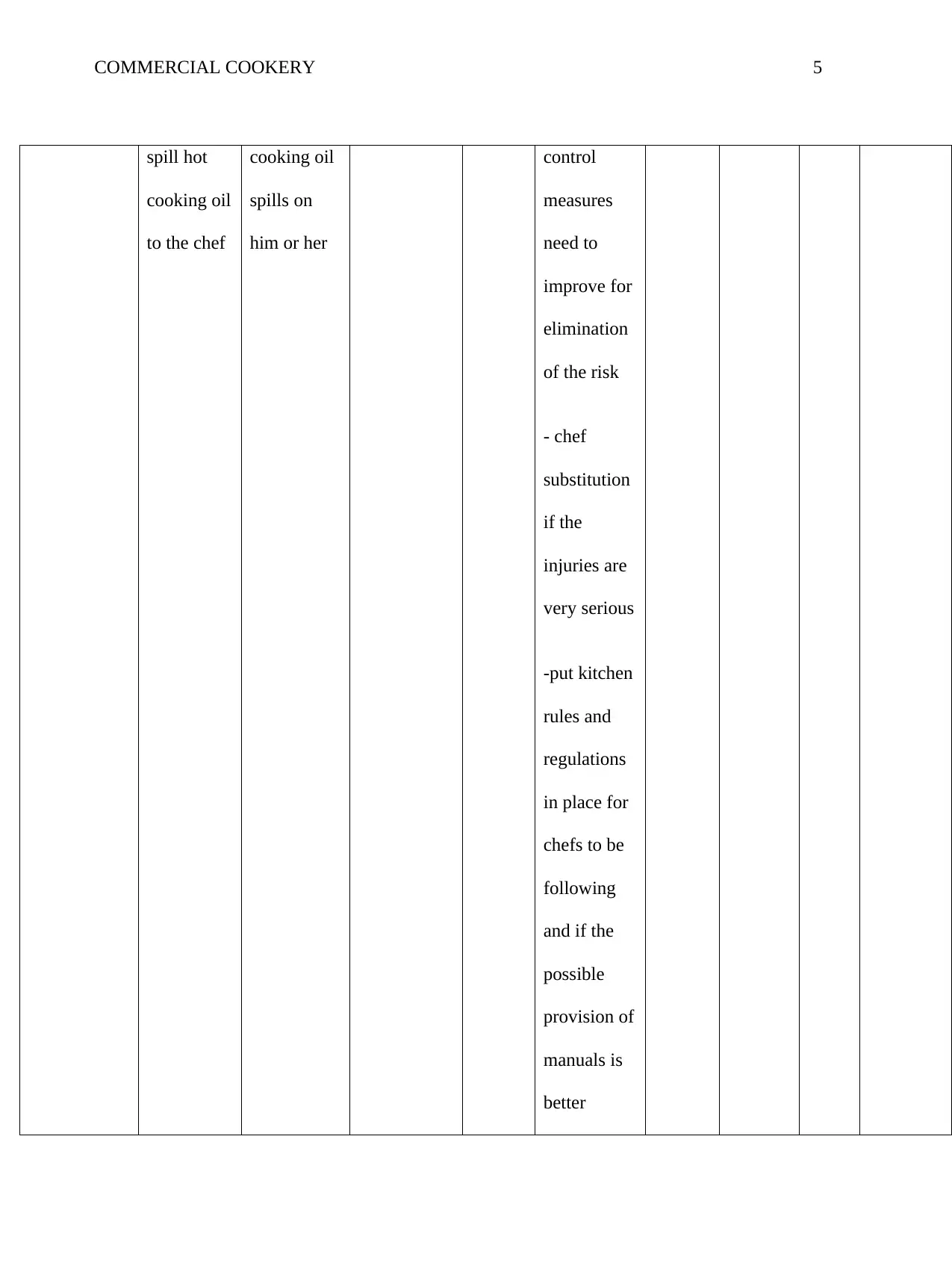
COMMERCIAL COOKERY 5
spill hot
cooking oil
to the chef
cooking oil
spills on
him or her
control
measures
need to
improve for
elimination
of the risk
- chef
substitution
if the
injuries are
very serious
-put kitchen
rules and
regulations
in place for
chefs to be
following
and if the
possible
provision of
manuals is
better
spill hot
cooking oil
to the chef
cooking oil
spills on
him or her
control
measures
need to
improve for
elimination
of the risk
- chef
substitution
if the
injuries are
very serious
-put kitchen
rules and
regulations
in place for
chefs to be
following
and if the
possible
provision of
manuals is
better
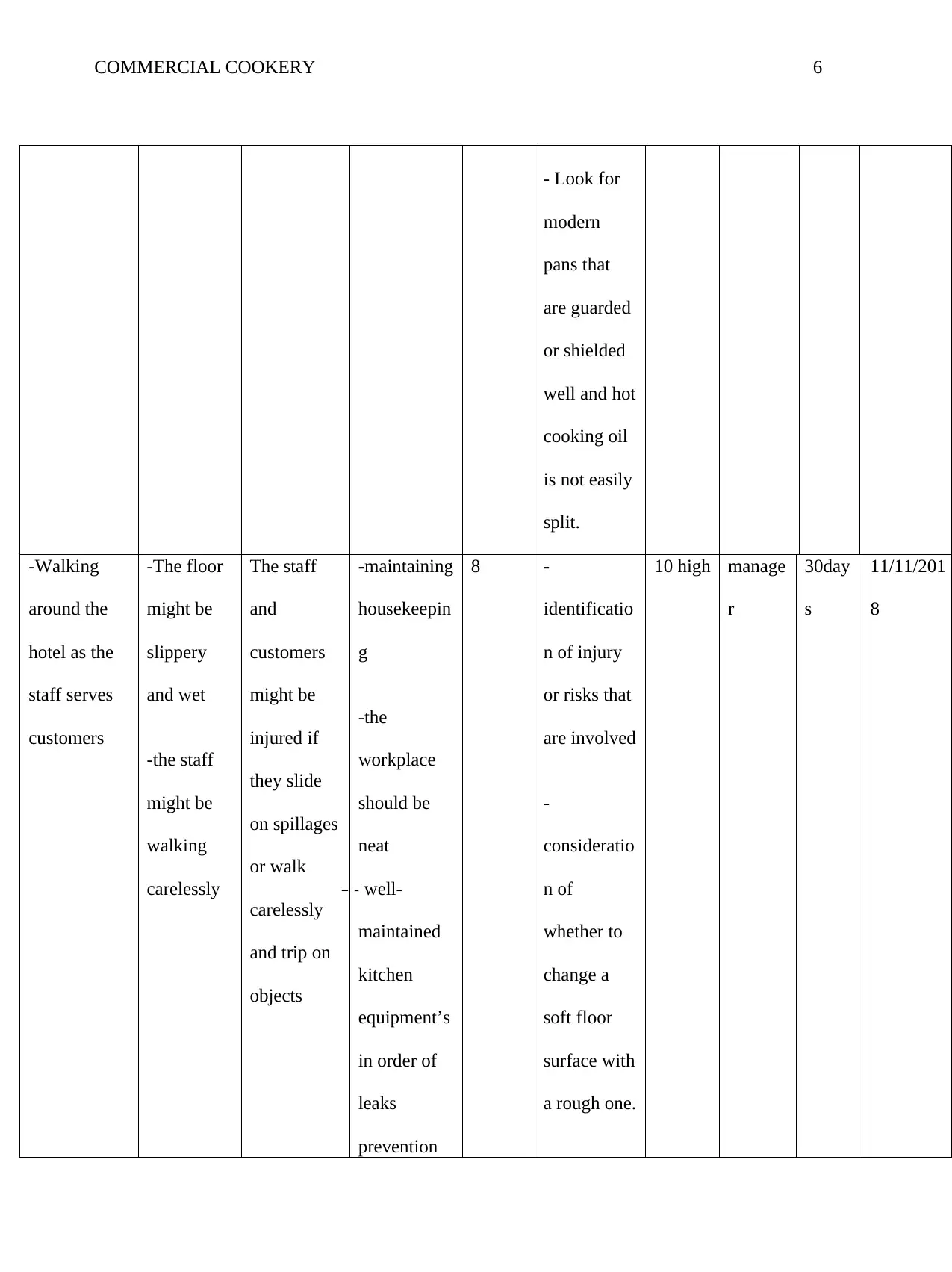
COMMERCIAL COOKERY 6
- Look for
modern
pans that
are guarded
or shielded
well and hot
cooking oil
is not easily
split.
-Walking
around the
hotel as the
staff serves
customers
-The floor
might be
slippery
and wet
-the staff
might be
walking
carelessly
The staff
and
customers
might be
injured if
they slide
on spillages
or walk
carelessly
and trip on
objects
-maintaining
housekeepin
g
-the
workplace
should be
neat
– - well-
maintained
kitchen
equipment’s
in order of
leaks
prevention
8 -
identificatio
n of injury
or risks that
are involved
-
consideratio
n of
whether to
change a
soft floor
surface with
a rough one.
10 high manage
r
30day
s
11/11/201
8
- Look for
modern
pans that
are guarded
or shielded
well and hot
cooking oil
is not easily
split.
-Walking
around the
hotel as the
staff serves
customers
-The floor
might be
slippery
and wet
-the staff
might be
walking
carelessly
The staff
and
customers
might be
injured if
they slide
on spillages
or walk
carelessly
and trip on
objects
-maintaining
housekeepin
g
-the
workplace
should be
neat
– - well-
maintained
kitchen
equipment’s
in order of
leaks
prevention
8 -
identificatio
n of injury
or risks that
are involved
-
consideratio
n of
whether to
change a
soft floor
surface with
a rough one.
10 high manage
r
30day
s
11/11/201
8
⊘ This is a preview!⊘
Do you want full access?
Subscribe today to unlock all pages.

Trusted by 1+ million students worldwide
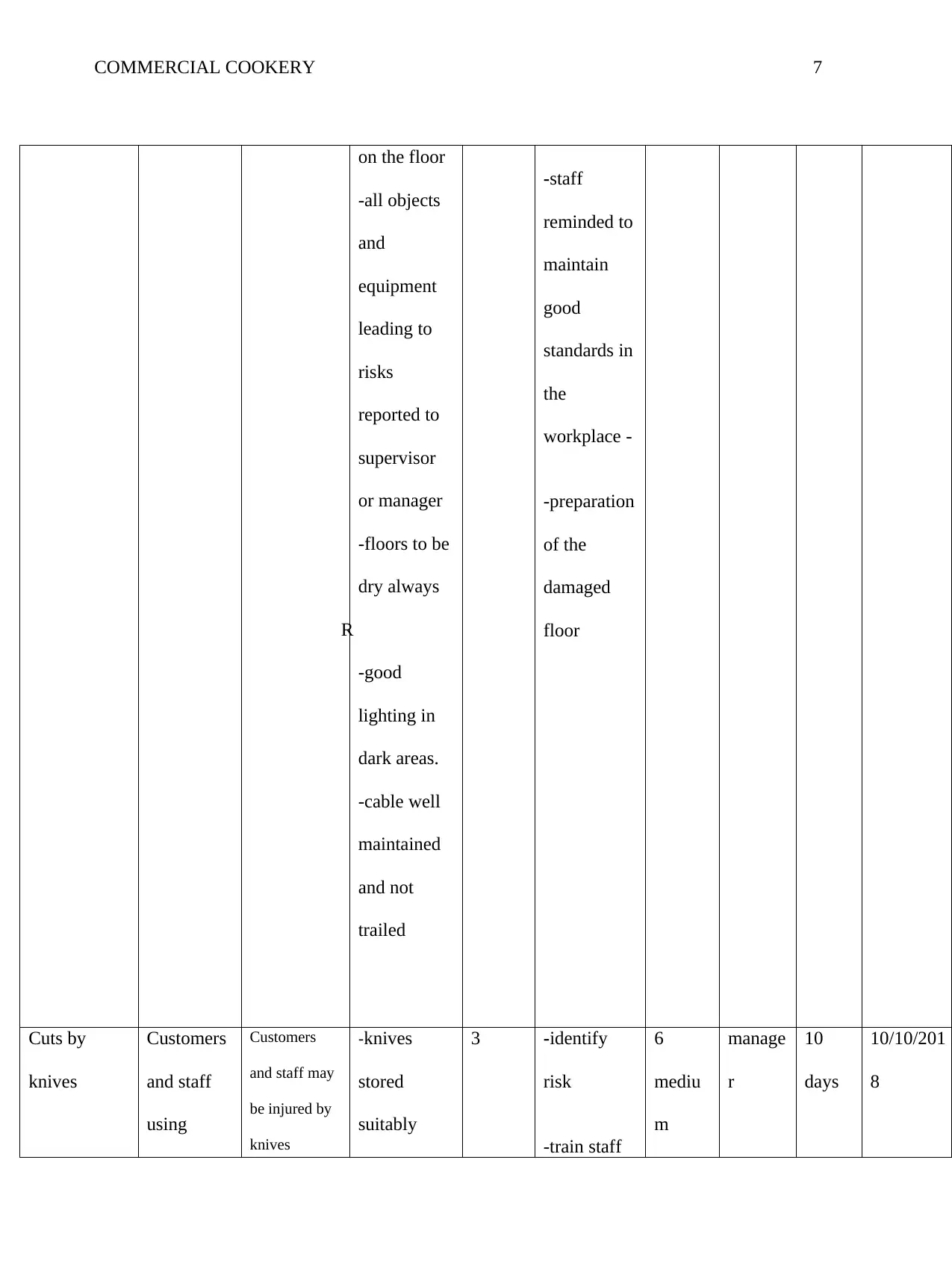
COMMERCIAL COOKERY 7
on the floor
-all objects
and
equipment
leading to
risks
reported to
supervisor
or manager
-floors to be
dry always
R
-good
lighting in
dark areas.
-cable well
maintained
and not
trailed
-staff
reminded to
maintain
good
standards in
the
workplace -
-preparation
of the
damaged
floor
Cuts by
knives
Customers
and staff
using
Customers
and staff may
be injured by
knives
-knives
stored
suitably
3 -identify
risk
-train staff
6
mediu
m
manage
r
10
days
10/10/201
8
on the floor
-all objects
and
equipment
leading to
risks
reported to
supervisor
or manager
-floors to be
dry always
R
-good
lighting in
dark areas.
-cable well
maintained
and not
trailed
-staff
reminded to
maintain
good
standards in
the
workplace -
-preparation
of the
damaged
floor
Cuts by
knives
Customers
and staff
using
Customers
and staff may
be injured by
knives
-knives
stored
suitably
3 -identify
risk
-train staff
6
mediu
m
manage
r
10
days
10/10/201
8
Paraphrase This Document
Need a fresh take? Get an instant paraphrase of this document with our AI Paraphraser
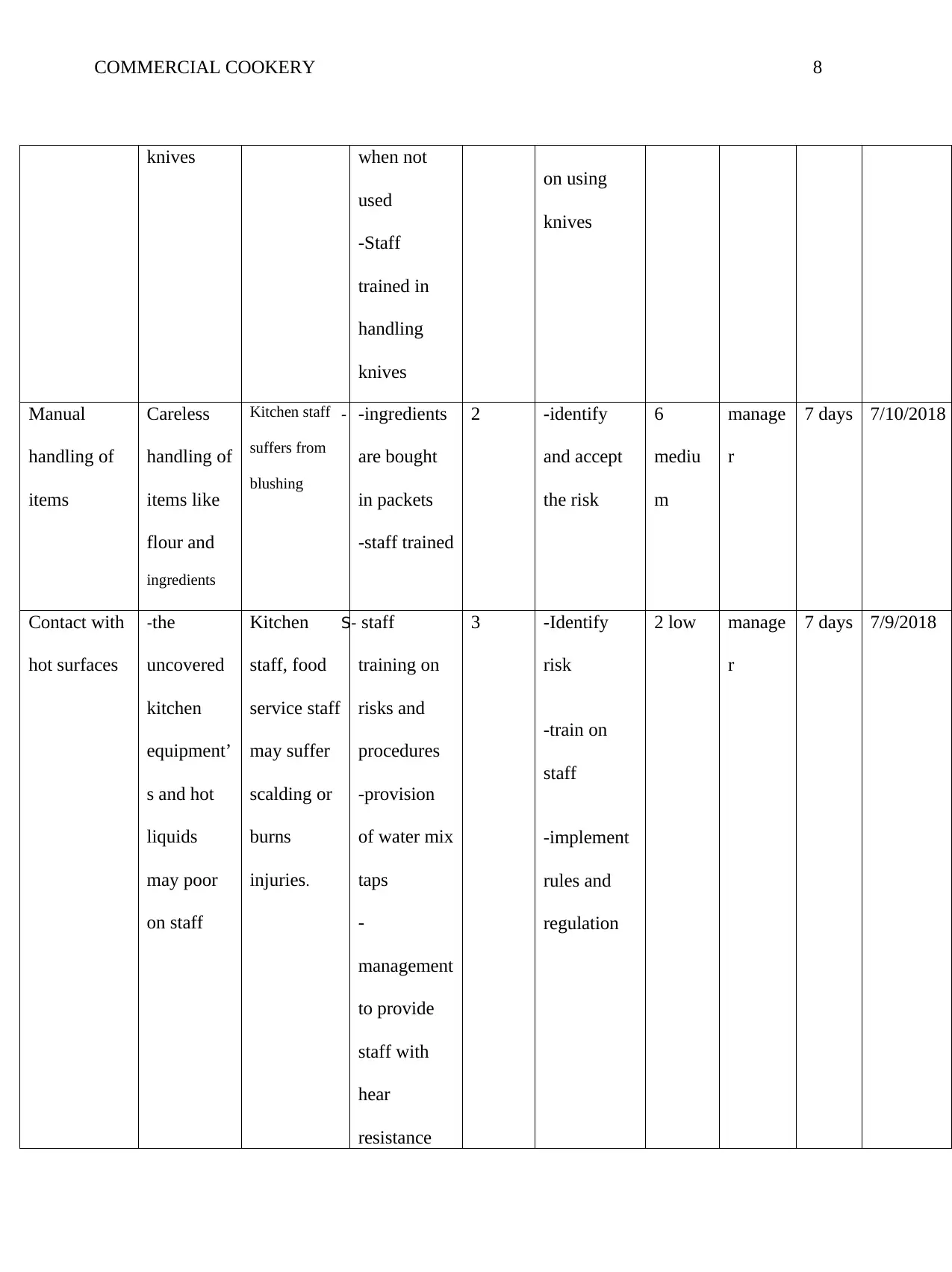
COMMERCIAL COOKERY 8
knives when not
used
-Staff
trained in
handling
knives
on using
knives
Manual
handling of
items
Careless
handling of
items like
flour and
ingredients
Kitchen staff
suffers from
blushing
- -ingredients
are bought
in packets
-staff trained
2 -identify
and accept
the risk
6
mediu
m
manage
r
7 days 7/10/2018
Contact with
hot surfaces
-the
uncovered
kitchen
equipment’
s and hot
liquids
may poor
on staff
Kitchen
staff, food
service staff
may suffer
scalding or
burns
injuries.
S- staff
training on
risks and
procedures
-provision
of water mix
taps
-
management
to provide
staff with
hear
resistance
3 -Identify
risk
-train on
staff
-implement
rules and
regulation
2 low manage
r
7 days 7/9/2018
knives when not
used
-Staff
trained in
handling
knives
on using
knives
Manual
handling of
items
Careless
handling of
items like
flour and
ingredients
Kitchen staff
suffers from
blushing
- -ingredients
are bought
in packets
-staff trained
2 -identify
and accept
the risk
6
mediu
m
manage
r
7 days 7/10/2018
Contact with
hot surfaces
-the
uncovered
kitchen
equipment’
s and hot
liquids
may poor
on staff
Kitchen
staff, food
service staff
may suffer
scalding or
burns
injuries.
S- staff
training on
risks and
procedures
-provision
of water mix
taps
-
management
to provide
staff with
hear
resistance
3 -Identify
risk
-train on
staff
-implement
rules and
regulation
2 low manage
r
7 days 7/9/2018
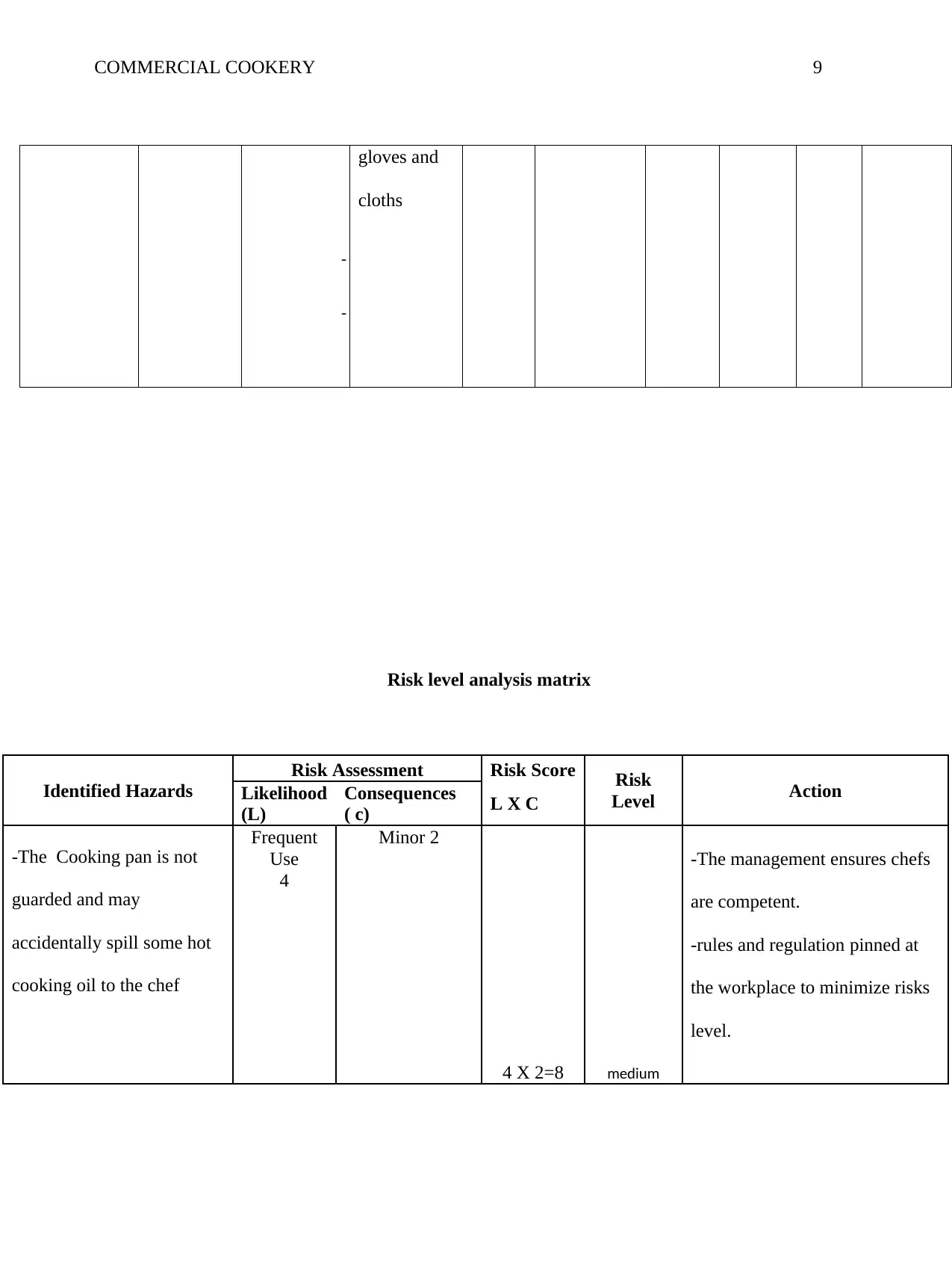
COMMERCIAL COOKERY 9
gloves and
cloths
-
-
Risk level analysis matrix
Identified Hazards
Risk Assessment Risk Score Risk
Level ActionLikelihood
(L)
Consequences
( c) L X C
-The Cooking pan is not
guarded and may
accidentally spill some hot
cooking oil to the chef
Frequent
Use
4
Minor 2
4 X 2=8 medium
-The management ensures chefs
are competent.
-rules and regulation pinned at
the workplace to minimize risks
level.
gloves and
cloths
-
-
Risk level analysis matrix
Identified Hazards
Risk Assessment Risk Score Risk
Level ActionLikelihood
(L)
Consequences
( c) L X C
-The Cooking pan is not
guarded and may
accidentally spill some hot
cooking oil to the chef
Frequent
Use
4
Minor 2
4 X 2=8 medium
-The management ensures chefs
are competent.
-rules and regulation pinned at
the workplace to minimize risks
level.
⊘ This is a preview!⊘
Do you want full access?
Subscribe today to unlock all pages.

Trusted by 1+ million students worldwide
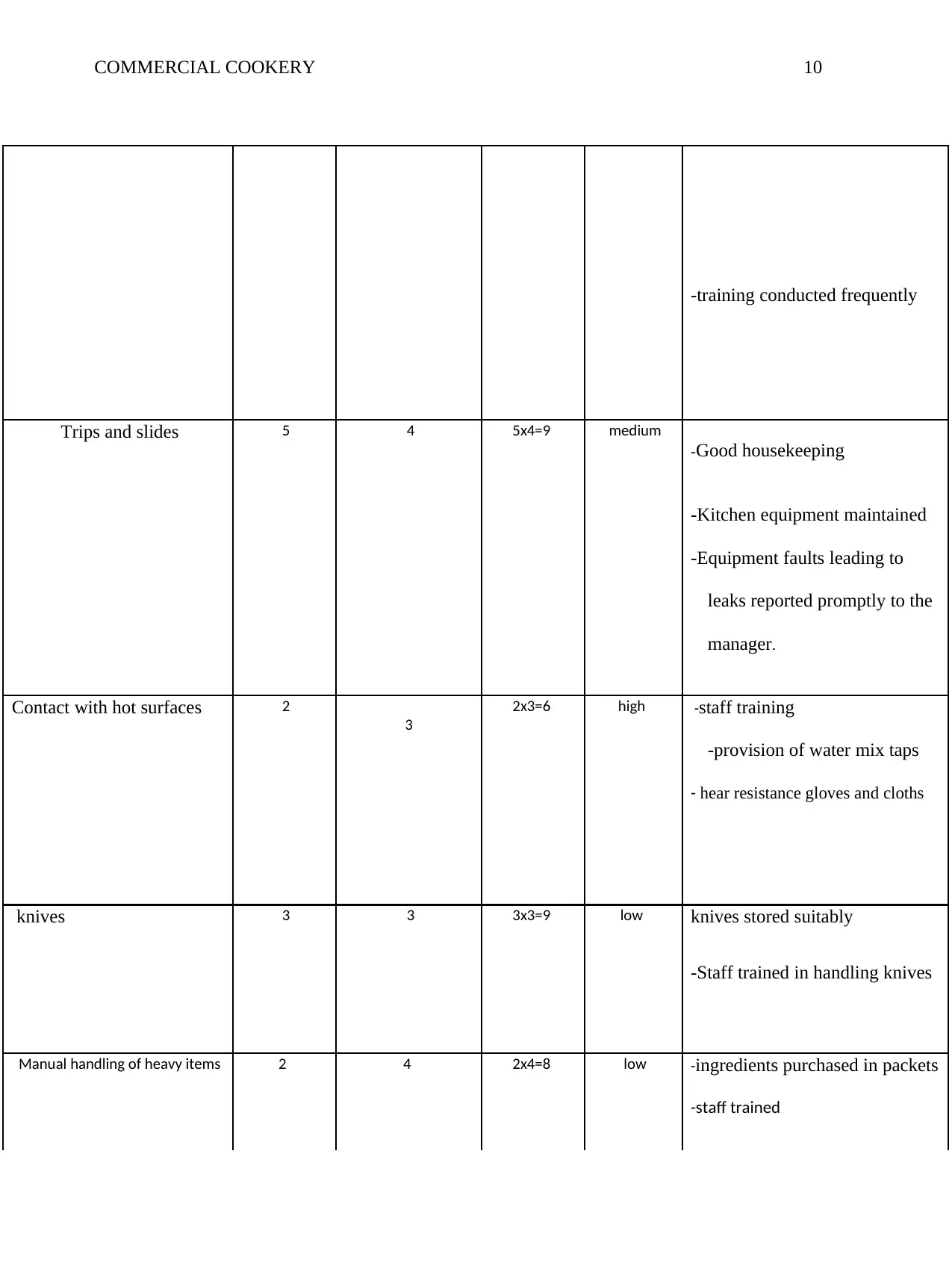
COMMERCIAL COOKERY 10
-training conducted frequently
Trips and slides 5 4 5x4=9 medium
-Good housekeeping
-Kitchen equipment maintained
-Equipment faults leading to
leaks reported promptly to the
manager.
Contact with hot surfaces 2
3
2x3=6 high -staff training
-provision of water mix taps
- hear resistance gloves and cloths
knives 3 3 3x3=9 low knives stored suitably
-Staff trained in handling knives
Manual handling of heavy items 2 4 2x4=8 low -ingredients purchased in packets
-staff trained
-training conducted frequently
Trips and slides 5 4 5x4=9 medium
-Good housekeeping
-Kitchen equipment maintained
-Equipment faults leading to
leaks reported promptly to the
manager.
Contact with hot surfaces 2
3
2x3=6 high -staff training
-provision of water mix taps
- hear resistance gloves and cloths
knives 3 3 3x3=9 low knives stored suitably
-Staff trained in handling knives
Manual handling of heavy items 2 4 2x4=8 low -ingredients purchased in packets
-staff trained
Paraphrase This Document
Need a fresh take? Get an instant paraphrase of this document with our AI Paraphraser
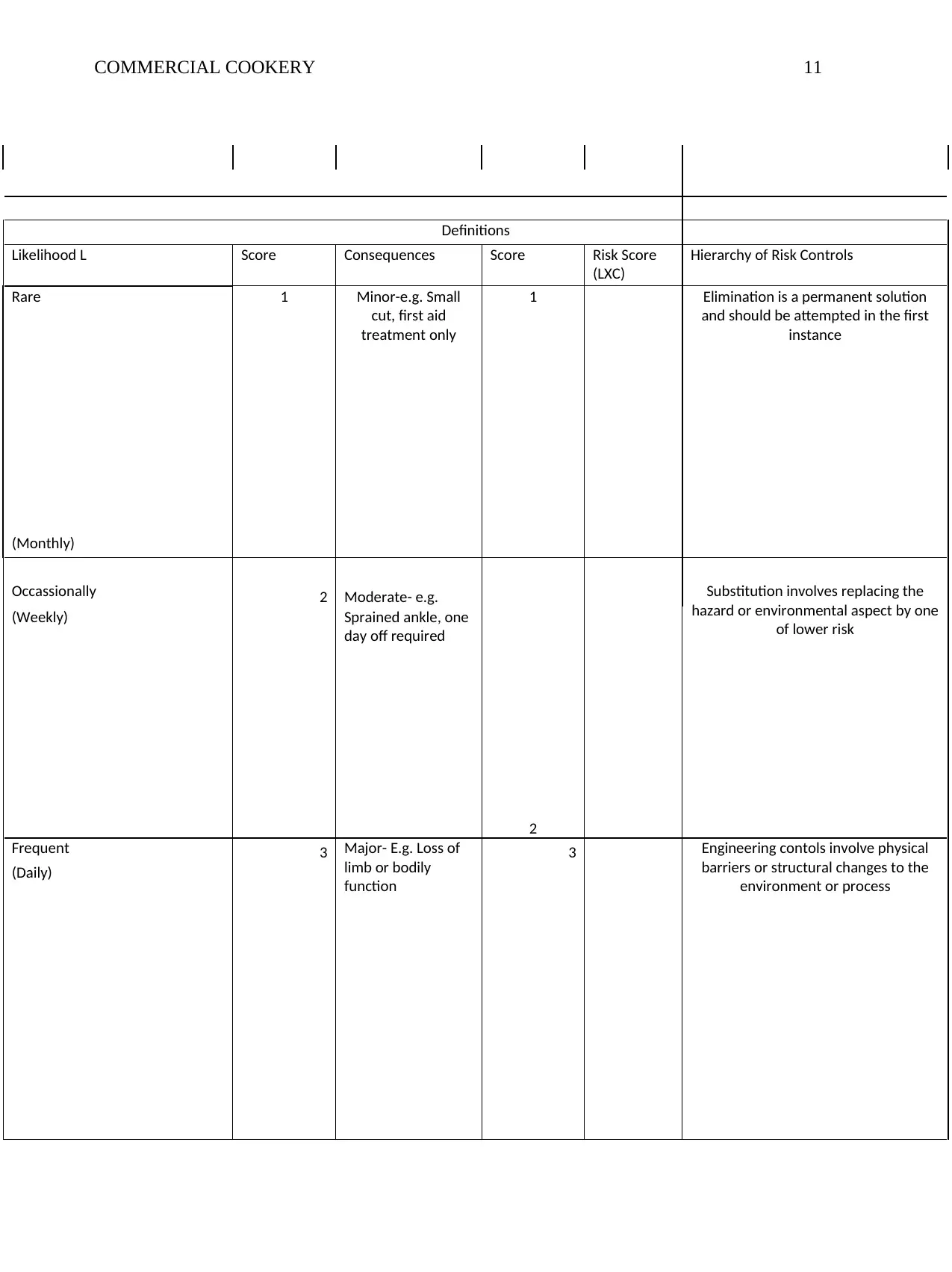
COMMERCIAL COOKERY 11
Definitions
Likelihood L Score Consequences Score Risk Score
(LXC)
Hierarchy of Risk Controls
Rare 1 Minor-e.g. Small
cut, first aid
treatment only
1 Elimination is a permanent solution
and should be attempted in the first
instance
(Monthly)
Occassionally 2 Moderate- e.g.
2
Substitution involves replacing the
hazard or environmental aspect by one
of lower risk
(Weekly) Sprained ankle, one
day off required
Frequent 3 Major- E.g. Loss of
limb or bodily
function
3 Engineering contols involve physical
barriers or structural changes to the
environment or process
(Daily)
Definitions
Likelihood L Score Consequences Score Risk Score
(LXC)
Hierarchy of Risk Controls
Rare 1 Minor-e.g. Small
cut, first aid
treatment only
1 Elimination is a permanent solution
and should be attempted in the first
instance
(Monthly)
Occassionally 2 Moderate- e.g.
2
Substitution involves replacing the
hazard or environmental aspect by one
of lower risk
(Weekly) Sprained ankle, one
day off required
Frequent 3 Major- E.g. Loss of
limb or bodily
function
3 Engineering contols involve physical
barriers or structural changes to the
environment or process
(Daily)
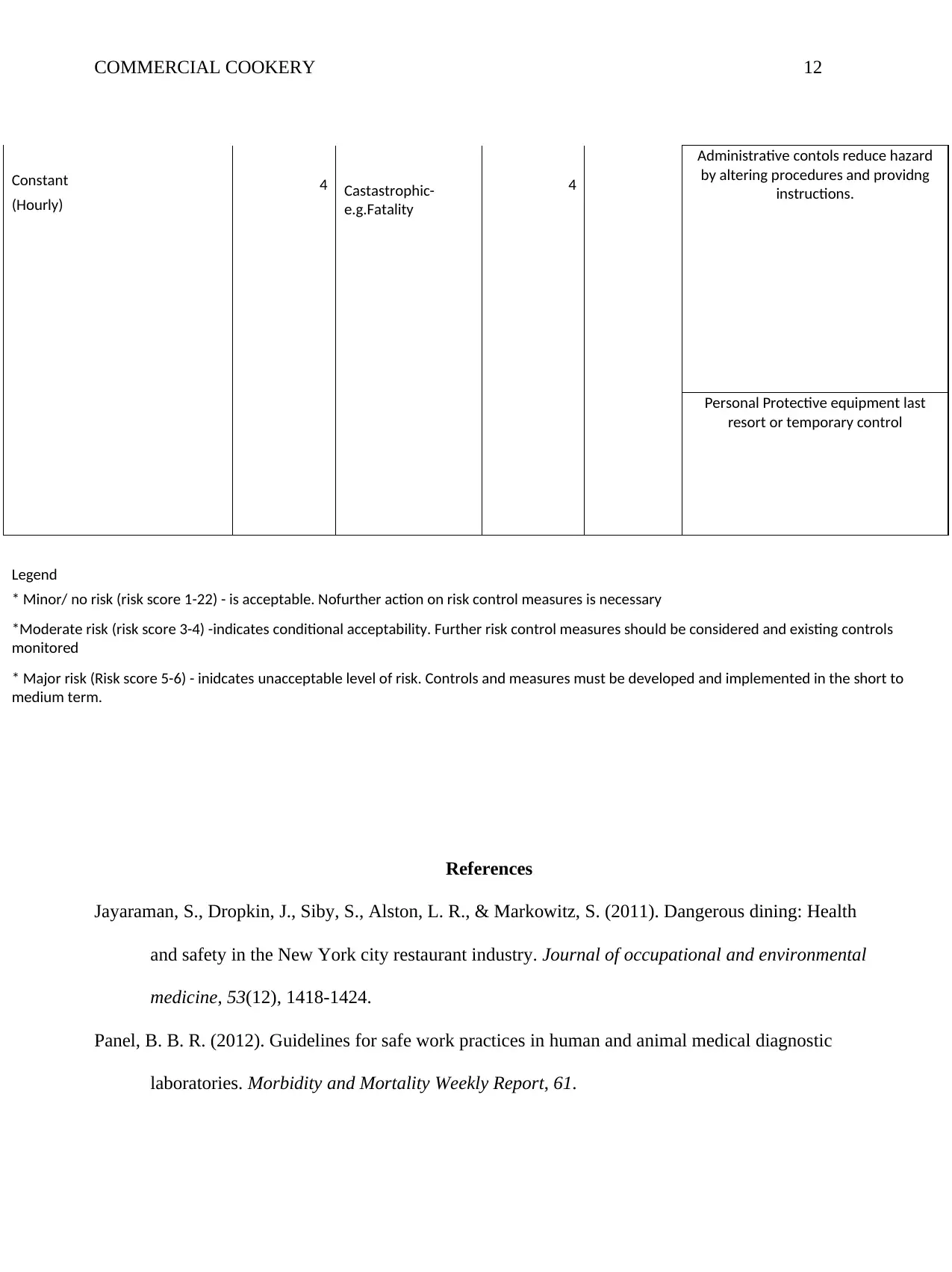
COMMERCIAL COOKERY 12
Administrative contols reduce hazard
by altering procedures and providng
instructions.
Constant 4 Castastrophic-
e.g.Fatality
4
(Hourly)
Personal Protective equipment last
resort or temporary control
Legend
* Minor/ no risk (risk score 1-22) - is acceptable. Nofurther action on risk control measures is necessary
*Moderate risk (risk score 3-4) -indicates conditional acceptability. Further risk control measures should be considered and existing controls
monitored
* Major risk (Risk score 5-6) - inidcates unacceptable level of risk. Controls and measures must be developed and implemented in the short to
medium term.
References
Jayaraman, S., Dropkin, J., Siby, S., Alston, L. R., & Markowitz, S. (2011). Dangerous dining: Health
and safety in the New York city restaurant industry. Journal of occupational and environmental
medicine, 53(12), 1418-1424.
Panel, B. B. R. (2012). Guidelines for safe work practices in human and animal medical diagnostic
laboratories. Morbidity and Mortality Weekly Report, 61.
Administrative contols reduce hazard
by altering procedures and providng
instructions.
Constant 4 Castastrophic-
e.g.Fatality
4
(Hourly)
Personal Protective equipment last
resort or temporary control
Legend
* Minor/ no risk (risk score 1-22) - is acceptable. Nofurther action on risk control measures is necessary
*Moderate risk (risk score 3-4) -indicates conditional acceptability. Further risk control measures should be considered and existing controls
monitored
* Major risk (Risk score 5-6) - inidcates unacceptable level of risk. Controls and measures must be developed and implemented in the short to
medium term.
References
Jayaraman, S., Dropkin, J., Siby, S., Alston, L. R., & Markowitz, S. (2011). Dangerous dining: Health
and safety in the New York city restaurant industry. Journal of occupational and environmental
medicine, 53(12), 1418-1424.
Panel, B. B. R. (2012). Guidelines for safe work practices in human and animal medical diagnostic
laboratories. Morbidity and Mortality Weekly Report, 61.
⊘ This is a preview!⊘
Do you want full access?
Subscribe today to unlock all pages.

Trusted by 1+ million students worldwide
1 out of 13
Your All-in-One AI-Powered Toolkit for Academic Success.
+13062052269
info@desklib.com
Available 24*7 on WhatsApp / Email
![[object Object]](/_next/static/media/star-bottom.7253800d.svg)
Unlock your academic potential
Copyright © 2020–2025 A2Z Services. All Rights Reserved. Developed and managed by ZUCOL.


